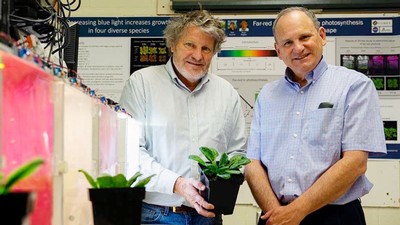Eclipse Excitement: USU Physicist Offers Tips for Observing April 8 Solar Show
By Mary-Ann Muffoletto |
USU Physics teacher James Coburn, standing, left, guides students in the use of solar telescopes. Coburn says Utahns, though not in the path of totality for Monday, April 8's total solar eclipse, can still observe the effects of the cosmic phenomenon. (Photo: USU/M. Muffoletto)
Utah, home of Utah State University’s multiple campuses around the Beehive State, isn’t in the path of totality for Monday, April 8’s solar eclipse. But that doesn’t mean Aggies can’t enjoy the much-anticipated cosmic event.
“We’ll be at about 50 percent obscurity here in Utah,” says James Coburn, teacher and lab supervisor in USU’s Department of Physics and director of the USU Observatory. “Weather permitting, we’ll see and feel the effects of the eclipse, which will include a darkening of the sky and a drop in temperature.”
Monday’s eclipse is a total solar eclipse, Coburn says, meaning the moon will pass between the Sun and the Earth, completely blocking the face of the Sun. The eclipse’s path will cross over North America, passing over Mexico’s Pacific coast at about noon MDT and rising diagonally eastward across the United States from Texas to Maine.
“We’ll start to experience the eclipse around 11:30 a.m.,” Coburn says. “It will reach its peak darkness about 12:30 p.m., which will be at about 47 percent obscurity, and then end around 1:40 p.m.”
While Utahns won’t observe a total eclipse, he says, they still need to practice safe viewing.
“At no time is it safe to look at the Sun without proper eye protection,” Coburn says. “This includes eclipse glasses certified with the ISO-12312-2 international standard and specialized solar telescopes. Ordinary sunglasses do not provide adequate protection.”
If one doesn’t have eclipse glasses, Coburn suggests indirect viewing methods – with one’s back to the Sun -- including a paper or cardboard pinhole projector or an ordinary kitchen colander.
“You can also view the shadows of the eclipse on the ground or sidewalk from the light shining through the leaves of trees,” he says.
Coburn says seeing the eclipse isn’t the only way to experience it.
“It’s fun to feel the drop in temperature and notice how dark it suddenly gets in the middle of the day,” he says.
To learn more about the eclipse, Coburn suggests visiting NASA’s website.
“The eclipse is an exciting phenomenon and a great way to learn about the Sun during Heliophysics Big Year,” he says. “It will be a while before North America experiences the next total solar eclipse. Parts of Alaska will view totality in 2033, but the contiguous United States won’t experience a total eclipse again until 2045.”
WRITER
Mary-Ann Muffoletto
Public Relations Specialist
College of Science
435-797-3517
maryann.muffoletto@usu.edu
CONTACT
James Coburn
Laboratory Supervisor
Department of Physics
435-797-3014
james.coburn@usu.edu
TOPICS
Space 140storiesComments and questions regarding this article may be directed to the contact person listed on this page.







